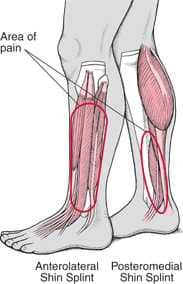 My shins are burning! If you’ve even gone for a run or even a brisk walk and felt like your lower leg muscles were on fire you were likely experiencing shin splints. Shin splints are the common term for pain along the shin bone caused by micro-tearing in the muscle and connective tissue that attach muscle to bone. The location of the shin splints depends on the muscle that is affected.
My shins are burning! If you’ve even gone for a run or even a brisk walk and felt like your lower leg muscles were on fire you were likely experiencing shin splints. Shin splints are the common term for pain along the shin bone caused by micro-tearing in the muscle and connective tissue that attach muscle to bone. The location of the shin splints depends on the muscle that is affected.
Medial shin splints are commonly felt along the lower, inner portion of the shin bone. These are generally caused by biomechanical issues such as over pronation. The tibialis posterior muscle is responsible for supporting the arch and in cases of overpronation during running it isn’t strong enough to do its job and begins hurting. This type of shin splints are better treated with addressing running mechanics, switching to a more supportive shoe and wearing a custom orthotic to prevent overpronation.
Lateral shin splints are typically painful along the outer upper half of the leg. This type is caused by increased demand on the tibialis anterior muscle. If you have begun a new exercise regime, increased your kilometers, increased your pace or increased your incline you are likely to develop this pain for a short period. Luckily once the muscle adapts to its new demands the shin splints should diminish. You can help this process along by stretching before and after activity, icing, getting a massage and wearing compression socks.
Shin splint recovery can take time; however you don’t have to stop activity completely. Cut back on distance or intensity and try a new sport that has less impact like cycling, swimming and weight training. If in doubt about your type of shin splints, the cause or how to heal them, consult a Certified Pedorthist!